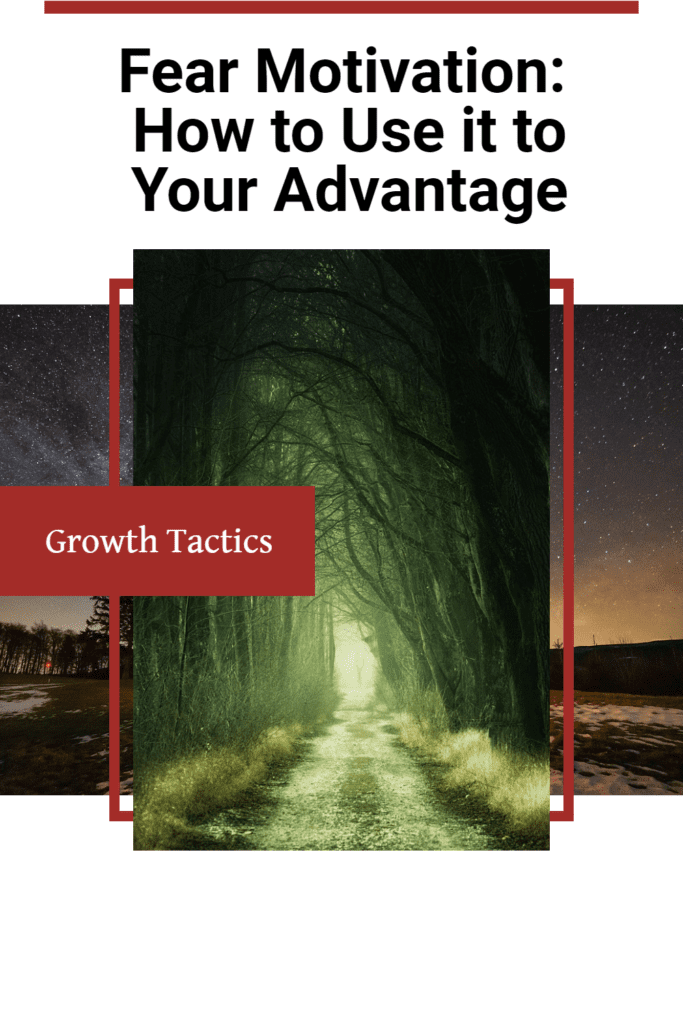Do you ever find yourself paralyzed with fear? It’s a natural response to situations that provoke strong emotions, but what if that fear could be harnessed and used to propel you forward? In this blog post, we’ll discover how fear can be a powerful motivator and show you how to use it to your advantage in achieving your goals.
Jump To Section
Can Fear Be a Motivator?
Understanding how fear can be a motivator is essential in unlocking its potential. We’ll explore the concept of fear-based motivation and delve into why it can be so effective in driving us towards our goals.
The Power of Fear and Anxiety
Fear and anxiety, often seen as negative emotions, can actually hold tremendous power. They might make us feel uncomfortable, but they can also serve as catalysts for personal growth and positive change. In this discussion, we’ll explore the relationship between fear, anxiety, and motivation, and uncover how they can be harnessed to propel us forward.
Embracing Fear: A Driver for Change
Fear can be an incredibly strong motivator. When we feel fear, it’s a signal that something is important to us or that we’re facing a challenge. It pushes us to take action, adapt, and overcome obstacles. By embracing fear, we can harness its energy and channel it towards achieving our goals. Fear becomes a driving force that propels us out of our comfort zone and towards personal growth.
The Power of Anxiety: Fueling Performance
Anxiety, on the other hand, is often seen as a hindrance. However, it can actually boost our performance and drive us to excel. When we’re anxious, our senses become heightened, and our focus becomes sharper. It’s like having an extra dose of adrenaline that helps us perform at our best. By reframing anxiety as a tool rather than a barrier, we can utilize its power to enhance our abilities and achieve extraordinary results.
Moving Beyond Limiting Beliefs
Both fear and anxiety are closely tied to our beliefs about ourselves and the world. They can stem from concerns of failure, rejection, or the unknown. However, by confronting and challenging these limiting beliefs, we can shift our mindset and tap into our true potential. When we reframe fear and anxiety as stepping stones rather than stumbling blocks, we pave the way for personal growth and transformative experiences.
Cultivating Resilience: Stepping Stones to Success
Fear and anxiety can be seen as stepping stones on the path to success. By facing our fears and embracing the discomfort of anxiety, we cultivate resilience. We become more adaptable and open to new opportunities. Over time, we develop confidence in our ability to navigate challenges, knowing that fear and anxiety are not roadblocks, but rather integral parts of our journey towards personal and professional fulfillment.
Reframing Fear in a Positive Light
Are you tired of feeling weighed down by fear? It’s time to reframe it in a positive light! Fear can be a powerful driver towards personal growth and achievement. So, let’s explore how to shift our mindset and embrace fear as a force for good.
Acknowledge Your Fear
The first step towards reframing fear is acknowledging it. We all experience fear at some point in our lives, and that’s okay. By recognizing our fears and where they come from, we can take steps to address them and move forward.
Embrace Discomfort and Uncertainty
Fear often arises from the discomfort of uncertainty. However, by reframing uncertainty as an opportunity for growth, we can begin to embrace it. Pushing ourselves out of our comfort zone can be scary but is fundamental for personal growth. By taking calculated risks, we become more resilient and better equipped to handle future challenges.
Recognize the Benefits
Fear can be a powerful motivator that drives us towards our goals. It can heighten our senses, make us more focused and determined, and help us perform at our best. By recognizing the benefits of fear, we can change our perception of it and utilize its energy to achieve extraordinary results.
Challenge Your Limiting Beliefs
Often, fear is driven by our limiting beliefs about ourselves and our abilities. However, by questioning and challenging these beliefs, we can break free from their constraints. We begin to see ourselves as more capable, confident, and resilient, opening up new opportunities and paths for personal and professional fulfillment.
Stepping Stones to Success
By reframing fear in a positive light, we pave the way for personal growth and success. Embracing discomfort, recognizing the benefits, and challenging limiting beliefs are just a few ways to harness the power of fear. Remember, fear is not a stumbling block but a stepping stone on your path toward achieving your goals.
So, the next time you feel fear creeping in, pause, acknowledge it, and reframe it in a positive light. Embrace the discomfort, recognize its benefits, and challenge your limiting beliefs, knowing that fear is not something to be overcome but a tool to be harnessed.
Using Fear-Based Motivation in the Workplace
Fear-based motivation is not limited to personal goals; it can also be applied in the workplace. Some managers resort to fear tactics to motivate their employees, but we’ll examine the potential consequences of relying on fear too heavily and suggest healthier alternatives.
Consequences of Using Fear as a Motivator in the Workplace Improperly
When it comes to motivating employees, fear can be a powerful tool. However, if not used correctly, it can have serious consequences. In this section, we’ll explore the downsides of using fear-based motivation in the workplace improperly.
Creates a Negative Workplace Culture
Using fear as a motivator creates a negative workplace culture that can be detrimental to the well-being of employees. It can lead to low morale, high turnover, and an overall lack of engagement. When employees are motivated purely by fear, they become focused on avoiding negative consequences rather than striving for positive outcomes.
Leads to Burnout and Stress
Fear-based motivation can also lead to burnout and stress, which can have a severe impact on employee productivity and health. Employees who are constantly stressed and fearful are more likely to suffer from physical and mental health problems, leading to absenteeism and decreased performance.
Reduces Creativity and Innovation
When employees are motivated by fear, they are less likely to take risks, be creative, and come up with new ideas. Fear-based motivation can lead to a culture of conformity, where employees are hesitant to speak up or suggest new approaches for fear of negative consequences.
Causes Micromanagement
Micromanagement is a common consequence of using fear as a motivator. Managers who rely on fear-based tactics often feel the need to closely monitor their employees’ every move, leading to a lack of trust and a stifling work environment. Micromanagement can be demotivating and counter-productive, leading to decreased productivity and lower job satisfaction.
Damages Trust and Employee Relationships
When employees are motivated by fear, their relationships with their managers and colleagues can become strained. Fear-based motivation erodes trust, leading to a toxic work environment that can be difficult to repair. It can take a long time to rebuild lost trust, resulting in a drop in productivity and morale.
Real-World Examples: The Power of Fear in Achieving Goals
In this section, we’re going to dive into some real-life examples that illustrate the power of fear in propelling individuals toward success. Get ready to be inspired!
Example 1: Elon Musk and SpaceX
When Elon Musk founded SpaceX, he knew he was taking on a colossal challenge. The fear of failure loomed large, but Musk harnessed that fear to push the boundaries of what was possible. His ambitious goal of revolutionizing space travel seemed daunting, but he transformed fear into a powerful motivator. Through relentless dedication, trial and error, and unwavering belief in his vision, Musk and his team successfully launched reusable rockets, dramatically reducing the cost of space exploration.
Example 2: Serena Williams and Overcoming Self-Doubt
Even sports legends like Serena Williams experience fear and self-doubt. Despite her unparalleled success, Williams has openly spoken about the fear she feels before major tournaments. Instead of letting it hold her back, she channels that fear into motivation. Williams uses it as a catalyst to push herself harder, refine her technique, and constantly improve. By embracing fear and transforming it into determination, she continues to achieve greatness on the tennis court.
Example 3: J.K. Rowling and the Fear of Rejection
Imagine if J.K. Rowling had let the fear of rejection stop her from pursuing her dream of writing the Harry Potter series. With countless rejections from publishers, it would have been easy for her to give up. However, Rowling refused to let fear dictate her future. She persisted, honed her craft, and self-published the first book. Today, the Harry Potter series has sold millions of copies worldwide, and Rowling is considered one of the most successful authors of all time.
Example 4: Oprah Winfrey and Pushing Past Comfort Zones
Oprah Winfrey, a household name synonymous with success, has always believed in the power of fear and pushing past comfort zones. Throughout her career, Oprah constantly sought out new challenges and ventures that initially left her feeling fearful and uncertain. However, instead of retreating, she leaned into those experiences. By embracing fear head-on, Oprah expanded her horizons, built a media empire, and became an influential figure inspiring millions around the world.
Conclusion
In summary, fear doesn’t have to hold us back; it can be the catalyst for achieving our goals. By understanding and harnessing the power of fear, we can unlock our true potential. Remember, fear is a natural emotion, and with the right mindset, it can become a powerful force that propels us towards success.


